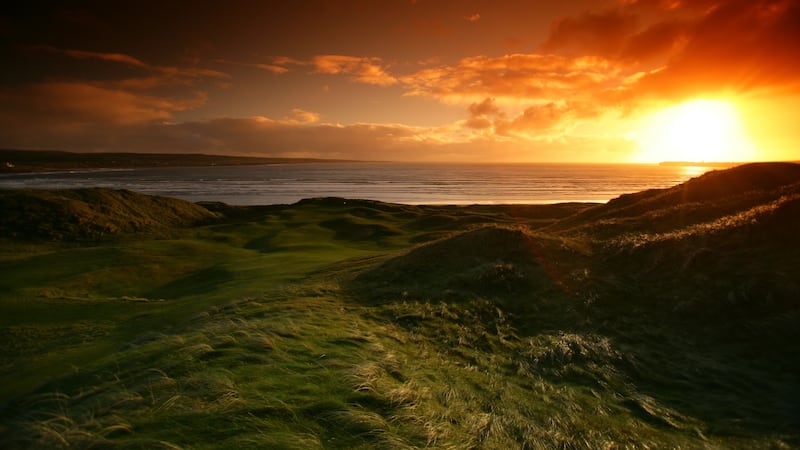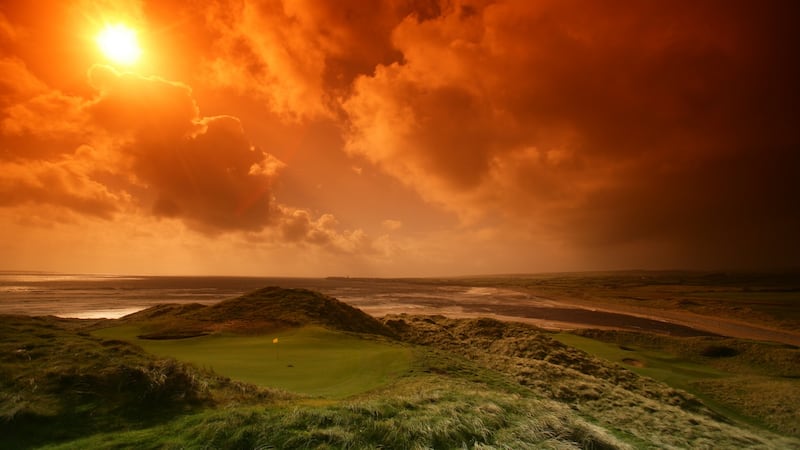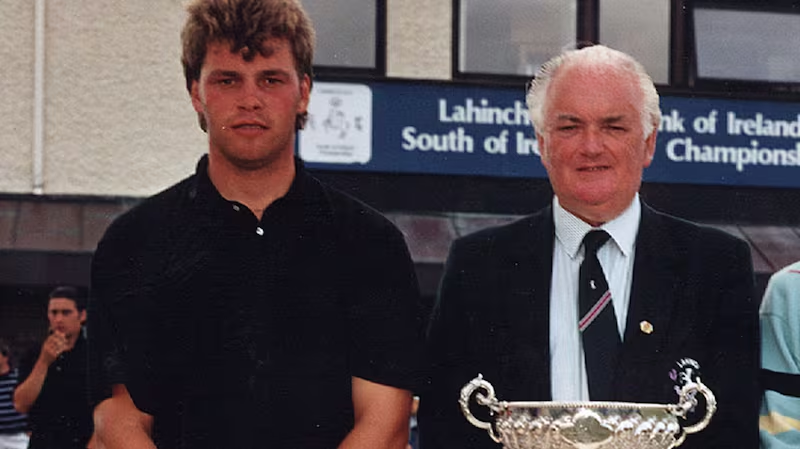Few experiences lift the spirits like when you see Liscannor Bay open up after climbing onto the sixth fairway at Lahinch, a hole Christy O’Connor Jnr said was one of the best par fours in golf. For golfers who visit Lahinch, it holds a special place in their hearts, as Paul McGinley, host for this week’s Dubai Duty Free Irish Open tournament, repeatedly references in his interviews promoting the event. “It’s a town that has a lot of goodwill,” he said, having added as a clincher: “The second green is 100 yards away from the pub”.
The village has always been a magnet for some of Ireland’s greatest amateur golfers to holiday there. McGinley won the South of Ireland amateur golf championship, or the ‘South’ as it’s known, in 1991 over the ‘Old Course’. He used to stay in a B&B and caddy for his dad in Lahinch as a kid. The first time he ever broke 70 was on the club’s second track, the ‘Castle Course’.
Years after winning the South of Ireland in 1950 and 1952, and in between beating Joe Carr in the final of the Irish Close championship in 1951, Mick Power used to stay in Lahinch every summer with his wife. Mick was built like Alfred Hitchcock. He had a fierce Cork accent, being from Muskerry. You used to hear him before you'd see him – as he gave it pepper on the accelerator of his old Renault car.
Mick stayed in the caravan park across the road from the main entrance to the golf club, which was owned by Brud Slattery who was also an iconic Lahinch figure. Brud's grandfather was one of the landowners who originally leased land for the course when it was founded in 1892. Brud served as club secretary/manager for 30 years but perhaps his greatest achievement was in winning the South in 1947 by rattling off seven consecutive threes in the final to beat 11-time winner John Burke on the 13th.
Rineen Ambush
The legendary Burke is synonymous with Lahinch golf club. He was also a gunman. He fought in the IRA’s 4th Battalion, Mid-Clare Brigade during the War of Independence. He was born in 1899 in Moy, a couple of miles out the Miltown Malbay road, close to where he later took part in one of the most notorious incidents in Co Clare history – the Rineen Ambush. In September 1920, an RIC lorry was travelling back towards Lahinch from Miltown Malbay when the IRA ambushed it, blasting it with a grenade and gunfire. Five RIC officers were killed. A sixth managed to flee the carnage but only got about 300 yards before being gunned down.
Burke took up golf several years later. He won the South the first time he entered it in 1928. He also won the Irish Close at the first attempt in 1930 and went on to win it four times in a row. He was such a formidable golfer that the local hotel owners in Lahinch – PJ Kerin, the proprietor of the Aberdeen Arms Hotel and Ned O’Dwyer of the Golf Links Hotel – asked him not to enter the South for much of the 1930s because they felt his presence put off other golfers from entering, which affected trade.

There’s a part of the course which is still known as “Burke’s Corner”. Older members would remember Burke often stood on the old third tee box and hit golf balls with every club in his bag onto the Par 3 green for kicks. The old third hole, a short devilish Par 3 – which Pádraig Harrington said was “one of the best golf holes you could ever play” and which was Burke’s brainchild – is no more.
The old golf club professional, Bill McCavery – who spent 60 years in the post from 1927 and whose grandson works in the club shop today – used to walk down from the village to the pro shop every day during the summer season. His route involved entering the Old Course by a little laneway, which is still there, by what was then the third tee-box. He always carried a scissors in his pocket and would snip at rogue tufts of grass he spotted on the second green while on his commute.
Caddying at the club was an education. Great money was up for grabs from Americans, especially in September when a caddy could do four bags a day – one on each shoulder in the morning and again in the afternoon. Canadians were notoriously tight-fisted, and there were also certain club members who were to be steered clear of. Their appearance in the car park would send junior caddies scurrying for cover.
June, July and August could be a hard grind. It was “first come, first served” so you had to be down at the caddy hut before sunrise to get your name on the list in the hope you’d get a bag in the morning. Otherwise you were condemned to holding out for the graveyard shift in the afternoon, often on an empty stomach. Back in the day, school principals used to give caddies leave from school for the two weeks of the members’ September meeting because they recognised it was an important source of income for local families.
Back around the 1940s and ’50s, members used to withhold paying out the regulation tip to caddies if they were “responsible” for losing their golf ball during a round. It was a Dickensian practice. Afterwards, caddies would group together and go out the course to trawl it for the lost golf ball. If retrieved, they’d give it to the caddy master and he’d cough up the tip.
A taxing day
The taxman raided the course in September 1993. Caddies weren't supposed to sign on the dole. As a caddy myself out on the course that day, it was some laugh looking at the baffled expressions of the golfers in our group as their caddies dropped their bags and fled over the hills. There's a cartoon on one of the walls in the Atlantic Hotel on the main street in the village by the cartoonist Terry Willers commemorating the bust: "A taxing day for the caddies at Lahinch."
Nearly all the caddies had nicknames: Eli, Gonnie, Zeb, Mopey, Bonzo, Sunshine, Knickers, Bosco, The Snake and the great Georgie Benn, who got christened "George V" when he took on a job directing traffic on the hill at the "Klondyke", which used to be the fifth hole before becoming the fourth today when they retired the old third hole.
American clients were fair game for all kinds of yarns: made-up stories like, say, that the ruins of the 14th century castle (which gave its name to the Castle Course) were for sale or that the English army once fought the Irish army either side of the Liscannor Road, which separates the Castle Course from the Old Course.

Caddies would lie when their man hit a ball onto the beach alongside the 12th fairway, which in the 1980s and 1990s used to be in play (but not anymore): “Bad luck, sir. You better re-load. It’s out of bounds.” No way would you want to be hacking around the beach unnecessarily, although if you were playing yourself it was a lovely feature to be able to hit back onto the fairway from the sand below.
A favourite caddy story from over the years relates to Noel Neylon. Noel used to sit at the bar counter in Galvin's, or "Combers" as it was known, a pub beside the church in the village, which is shut now. He was out the course one day caddying for a hacker. His man was halfway up the fairway on a par four when he asked Noel if a 7-iron would reach the green. "Eventually," came the disgruntled reply.
Major winners
The game's great golfers used to roll in to play the course every now and again, including a visit by Byron Nelson in the 1960s. Major winners like Greg Norman, David Duval, Mark O'Meara, Jim Furyk, Bubba Watson, Phil Mickelson, who once said that Lahinch and Augusta National were his two favourite golf courses, and Stewart Cink, who credits playing Lahinch on the Sunday before the 2009 British Open as valuable warm-up for the links conditions he was set to face at Turnberry.
Cink beat a 59-year-old Tom Watson in a playoff to win that year's British Open. Watson played Lahinch a year or two after he won the last of his five British Open titles in 1983. BB Dillon, whose son-in-law became caddymaster a few years later, was on Watson's bag that day. BB over-clubbed his second shot to the elevated green on the par four first. Word has it that Watson – who over-shot the green by about 50 yards, the ball coming to rest down by the Klondyke fairway – made his own club selection thereafter.
At the end of his round, Watson lost a ball in the rough on the left-hand side of the fairway from a pulled tee-shot on the 18th. It’ll be interesting to see if any of the competitors in this year’s Irish Open suffer a similar fate, particularly if they’re in contention on the Sunday afternoon.
The link between Lahinch and Augusta National
Several architects have worked on Lahinch golf course, including Old Tom Morris who is responsible for the club's most renowned holes – the Klondyke (involving a drive into a valley and a blind shot over a hill for your second) and the Dell (a blind par three). The layout of the Old Course is synonymous, though, with the hand of Dr Alister MacKenzie, whose other works include Augusta National and Cypress Point. Born in 1870, the Scottish doctor served as a surgeon during the Boer War and as an inventor of camouflage methods in the Great War. He was invited to visit Lahinch in 1927 to begin work on a re-design and was responsible for the course's signature plateau greens and, crucially, for bringing all 18 holes onto the sandhills side of the road. Previously several of the holes were on the other side of the Liscannor Road, where today's Castle Course resides. MacKenzie was smitten with the raw material in his hands, concluding: "Lahinch will make the finest and most popular golf course that I, or I believe anyone else, ever constructed."
South of Ireland anecdotes
Part of the mystique of Lahinch Golf Club is wrapped up with the South of Ireland amateur golf championship, which it has been hosting since its inception in 1895. The pictures of its finalists adorn the clubhouse walls, and they include winners Darren Clarke (1990), Paul McGinley (1991), Graeme McDowell (2000) as well as twice beaten finalist Pádraig Harrington (1994, 1995).

McDowell celebrated his 21st birthday drinking in Kenny's pub in Lahinch with his friend Ricky Elliott (who has a lucrative job as Brooks Koepka's caddy these days) en route to winning the South in 2000. They played each other in the last 32 that year. McDowell won on the 16th in horrendous weather conditions. Elliott caddied for him in the next couple of rounds until McDowell met a college buddie of Elliot's, Tim Rice, in the semi-final. That has been a tradition with golfing mates once they were eliminated. McDowell, for example, caddied for Elliot once McDowell got knocked out by Jody Fanagan in an earlier round in 1999. Alongside the illustrious players who have won the South there is also the notable achievement of Noel Pyne, a hurler with Clare and Munster's Railway Cup teams during the 1960s. In 2012, aged 66, Noel played in his 50th consecutive South of Ireland championship. What a feat.












